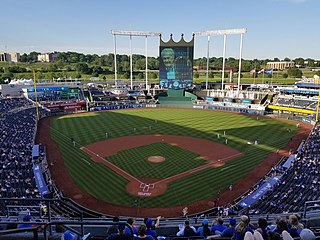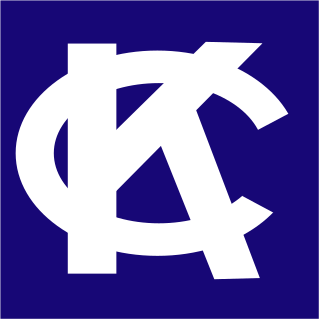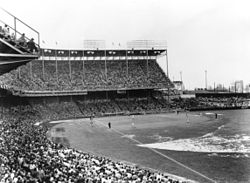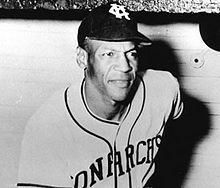
Charles Oscar Finley, nicknamed "Charlie O" or "Charley O", was an American businessman who owned Major League Baseball's Oakland Athletics. Finley purchased the franchise while it was located in Kansas City, moving it to Oakland in 1968. He is also known as a short-lived owner of the National Hockey League's California Golden Seals and the American Basketball Association's Memphis Tams.

Kauffman Stadium, often called "The K", is a baseball stadium located in Kansas City, Missouri. It is the ballpark to the Kansas City Royals of Major League Baseball (MLB). It is part of the Truman Sports Complex together with the adjacent Arrowhead Stadium, home of the Kansas City Chiefs of the National Football League (NFL). The stadium is named for Ewing Kauffman, the founder and first owner of the Royals. It opened in 1973 as Royals Stadium and was named for Kauffman twenty years later on July 2, 1993. Since its last major renovation in 2009, the listed seating capacity is 37,903.

William Hendrick Foster was an American left-handed pitcher in baseball's Negro leagues in the 1920s and 1930s, and had a career record of 110–56. He was elected to the Baseball Hall of Fame in 1996. Foster was the much-younger half-brother of Rube Foster, a Negro league player, pioneer, and fellow Hall of Famer.
The Homestead Grays were a professional baseball team that played in the Negro leagues in the United States.

The Kansas City Monarchs were the longest-running franchise in the history of baseball's Negro leagues. Operating in Kansas City, Missouri, and owned by J. L. Wilkinson, they were charter members of the Negro National League from 1920 to 1930. J. L. Wilkinson was the first white owner at the time of the establishment of the team. In 1930, the Monarchs became the first professional baseball team to use a portable lighting system which was transported from game to game in trucks to play games at night, five years before any MLB team did. The Monarchs won ten league championships before integration, and triumphed in the first Negro League World Series in 1924. The Monarchs had only one season in which they did not have a winning record. The team produced more major league players than any other Negro league franchise. It was disbanded in 1965.
A night game, also called a nighter, is a sporting event that takes place, completely or partially, after the local sunset. Depending on the sport, this can be done either with floodlights or with the usual low-light conditions. The term "night game" is typically used only in reference to sports traditionally held outdoors. Although indoor sporting events often take place after local sunset, these events are artificially lighted regardless of the time of day they take place.

The Kansas City Blues were a minor league baseball team located in Kansas City, Missouri, in the Midwestern United States. The team was one of the eight founding members of the American Association.

Andrew Lewis Cooper, nicknamed "Lefty", was an American left-handed pitcher in baseball's Negro leagues. He was elected to the Baseball Hall of Fame in 2006. An alumnus of Paul Quinn College, Cooper played nine seasons for the Detroit Stars and ten seasons for the Kansas City Monarchs, and briefly played for the Chicago American Giants. The Texan was 6 feet 2 inches (188 cm) tall and weighed 220 pounds.
The 1942 Negro World Series was a best-of-seven match-up between the Negro American League champion Kansas City Monarchs and the Negro National League champion Washington-Homestead Grays. In a six-game series, the Monarchs swept the Grays four games to none, with two additional games not counted in the standings. The Monarchs actually won the 1942 series 5-1, but a second game played in Yankee Stadium on September 13 was not counted by prior agreement, and the only game played in Kansas City was thrown out on appeal when the Grays used unauthorized players from other NNL teams.
The 1996 Major League Baseball season was the final season of league-only play before the beginning of interleague play the following season. The season ended with the New York Yankees defeating the defending champion Atlanta Braves in six games for the World Series title, the Yankees' first championship since 1978. The record for most home runs hit in an MLB regular season, set at 4,458 in 1987, was broken, as the AL and NL combined to hit 4,962 home runs. Only 196 shutouts were recorded in the 2,266 MLB regular-season games. This was the first season in the Divisional Series era to be played to the full 162 games, as the 1994–95 player's strike caused the first two seasons of the era to be abbreviated.
The 1969 Kansas City Royals season was the Royals' inaugural season. The team finished fourth in the newly established American League West with a record of 69 wins, 93 losses, and 1 tie.
The 1964 Kansas City Athletics season was the tenth for the franchise in Kansas City and the 64th overall. It involved the A's finishing tenth in the American League with a record of 57 wins, 105 losses and one tie, 42 games behind the American League Champion New York Yankees.
The 1955 Kansas City Athletics season was the 55th season for the franchise in MLB's American League, and the first season in Kansas City after playing the previous 54 in Philadelphia. The team won 63 games – only the fifth time in 20 years that they won more than 60 games – and lost 91, finishing sixth in the American League, 33 games behind the AL Champion New York Yankees.
The history of the Athletics Major League Baseball franchise spans the period from 1901 to the present day, having begun as a charter member franchise in the new American League in Philadelphia before moving to Kansas City in 1955 for 13 seasons and then to the San Francisco Bay in Oakland, California, in 1968. The team endured numerous attendance issues stemming from the aging Oakland Coliseum before the MLB owners approved the team's application to relocate to Las Vegas, Nevada in 2023.
George Toma is an American groundskeeper who specializes in working on sports facilities. Toma is one of the few surviving people to have attended every Super Bowl game, from 1967 to 2023.
The 1929 Kansas City Monarchs baseball team competed in the Negro National League during the 1929 baseball season. The Monarchs compiled a 63–17 (.788) record and won the Negro National League championship. The team played its home games at Muehlebach Field in Kansas City, Missouri.
The 1924 Kansas City Monarchs baseball team competed in the Negro National League during the 1924 baseball season. The Monarchs compiled a 57–22 (.722) record and won the Negro National League championship. The team played its home games at Muehlebach Field in Kansas City, Missouri.
The 1923 Kansas City Monarchs baseball team competed in the Negro National League during the 1923 baseball season. The Monarchs compiled a 61–37 (.622) record and won the Negro National League championship. The team played its home games at Muehlebach Field and Association Park in Kansas City, Missouri.
















